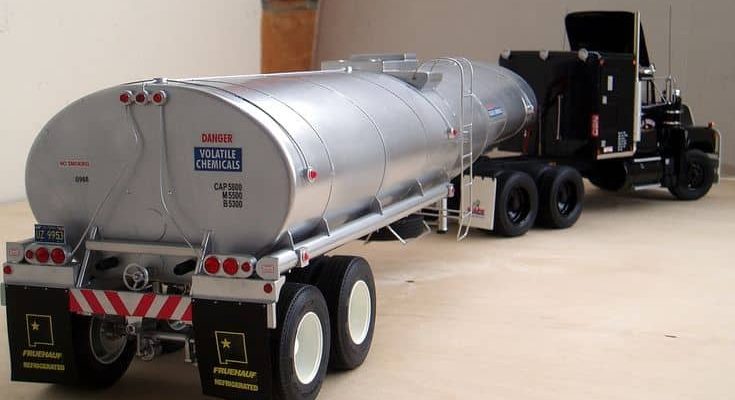Not many ponder over the huge industrial giants that emerge in front of them on the highway- the huge tanker trucks that have liquids or gases that are potentially explosive and go on across thousands of mile every single day. .

A close up shot reveals a small detail, which however goes unnoticed, when viewed by those people who have thought of it, once. A metal chain drags loosely under the back of the truck. Most of us think of it as a by-product of something or a piece left out, yet in reality, it is a brilliant safety measure so as to avoid disaster.
This hanging chain is not a decorative object, and this is not an archaic hardware. It has a very crucial and purposeful part in ensuring safety of the vehicle and the surrounding. Precisely, it is a grounding chain, something much needed and essential to combat the seemingly unseen but lethal power of static electricity.
Tanker trucks particularly those that carry combustible products like gasoline, diesel, jet fuel, industrial solvent or even some food-related liquids like alcohol are run on strict safety measures. Among the least noticeable (though among the most dangerous as well) dangers of the transport process one should count the accumulation of static electricity.

In the case of a moving tanker truck, there are several mechanisms which have a finger in the pot of generating static. First, when the truck is running over asphalt, the tires on it rub against the road generating some sort of friction, which in turn creates an electrical charge.
More importantly, the fluid in the tanker (particularly petroleum-based) always swirls and sloshes against the walls of the tanker. The combination of this movement, the rapidity of delivery and mixing of various materials, means that there is a consistent build-up of static charge in the tank.
Uncontrolled, this charge can quickly flow out in a spark discharge and with flammable vapors a spark can be disastrous. Even a single electrostatic spark is enough to set vaporized fuel aflame during loading/unloading or even on the road in case a vapor escapes through valves/vents.
The grounding chain, hanging at the rear axle or bumper, dragging in contact with the pavement, dissipates the accumulating static charge on tanker body to the ground continually. It is called earthing or grounding. The links of the chain made of metal directly connect to the ground, which eliminates the charge without causing an extreme amount of danger to it before the charge can be dangerous.
Technically the grounding chain serves as a portable grounding electrode. This is due to the fact that it is always in touch with the earth even when the car is moving, it makes the truck metal parts at equal electrical potential with the ground. This excludes the formation of a voltage difference that can cause a discharge.

This continuous loss of this type of static is important, although it is a very simple-to-construct device, when the truck stops to load or unload. It is during those times when hoses are attached, valves opened and where most probable and likely vapors can escape that there is a high concern about the risk of a spark. Unless it is properly grounded, that invisible static energy can only go out with possibly fatal results.
Implementation of grounding chains was not a day event. When fuel transport was first introduced (and in particular in the mid-XV century) static-caused fire incidents were the depressingly frequent occurrence. Tankers used to drive into fueling stations and hook up with hoses, and in short order they would come to life with fire because of ungrounded static discharges.
Regulatory bodies started to enforce safety requirements worldwide as it was being discovered that the cause of the explosion was due to the action of the static electricity. Grounding chain was one of the first and simplest solutions as it could be cheap and installable and quite effective. Consequently, grounding chains became almost an industry standard, and still are used in virtually every jurisdiction almost immediately.

The department of Transportation (DOT), National Fire Protection Association (NFPA) and Occupational Safety and Health Administration (OSHA) regulations in the United States encompass some specifications regarding grounding in the safety codes. Likewise, tanker truck rules using other grounding systems are required in other parts of the world: in Europe in the ADR regulations and others, and in Asia and the Middle East in other codes.
Although the conventional grounding chain is still being used, modern fuel transportation sector has also adopted new technology to achieve higher practice of safety. It has also become common to install static grounding reels on many tanker trucks these days– grounds made of retractable cables with clamps that can actually be clamped onto grounding rods or other terminals at loading stations. These supply a more conscious and safe ground connection that is advantageous primarily when at stop.
Some operations have anti static additives mixed in the fuel or chemicals they are carrying. The additives used deliver at the molecular level to suppress the fluid via the availability of charge potential. Also, non-conductive or static-dissipative coatings are applied to the internal surfaces of pipes and tanks by the manufacturers with the aim of reducing the possibility of forming a charge further.

Due to this important characteristic, that is, fail-safe, the grounding chain remains in use even in the era of advanced technological developments. A dragging chain is also different to a clamp or cable because it can operate automatically and endlessly without a person having to physically remember to open it or forget to either open or close a cable. It is constantly on as well as when it is moving.
Even the average person and at times even amateur drivers in the transport industry may look at the chain and have their assumptions. Others tend to think they are a piece of braking and some think it is a leftover of a tow hitch or a stabilizer. It is viewed by others as antique, an artifact of a long forgotten past when electronics came to dominate. All of these are not true.
As a matter of fact, a malfunctioned or incomplete chain may lead to unsuccessful inspection of the safety and legal liability of the transport companies. It is taken seriously by regulators, just as brake lights or tire tread. And quite understandably, as any oversight might lead to uncontrollable fire or blast, which might cause damage to the lives and property.
As important as a grounding chain is having one, so does proper working condition. These are chains that have a hard life: dragged on tarmac, get dirty, get linkages worn out and even get exposed to water, salt and chemicals. When they are very short and when they or their connection codes are corroded they will not cause sufficient grounding.

Daily maintenance steps as well as pre-trip checks involve ensuring that the chain is well fastened, in good condition and is long enough to ensure there is contact on the ground. When some driver realizes that the chain is no longer in contact with the pavement on a regular basis, this has to be repaired or changed as soon as possible. Grounding systems can work only when they are working.
Safety, when applied to transport of highly dangerous goods, like large quantities of flammable and toxic liquids, doesn t refer to glamorous technology or well-known devices. Many times it is the little, minor details that are needed like a steel chain dragging along the side of a truck going 60 miles an hour.
Although this chain may not look much like a high-maintenance piece, it has the weight on its shoulders, while ensuring the safety of its driver and his or her freight is one thing, ensuring the safety of all other road users is a different thing altogether. It is a measure of the wisdom of engineering and profound grasp of physical science – in this case electrostatics-(to avert disaster in the womb before it ever happens.)
OLYMPUS DIGITAL CAMERA
” data-medium-file=”https://i0.wp.com/middleagedclub.com/wp-content/uploads/2025/06/ytu567567567.jpg?fit=300%2C175&ssl=1″ data-large-file=”https://i0.wp.com/middleagedclub.com/wp-content/uploads/2025/06/ytu567567567.jpg?fit=735%2C428&ssl=1″ src=”https://i0.wp.com/middleagedclub.com/wp-content/uploads/2025/06/ytu567567567.jpg?resize=735%2C428&ssl=1″ alt=”” styles=”width:787px;height:auto” srcset=”https://i0.wp.com/middleagedclub.com/wp-content/uploads/2025/06/ytu567567567.jpg?w=735&ssl=1 735w, https://i0.wp.com/middleagedclub.com/wp-content/uploads/2025/06/ytu567567567.jpg?resize=300%2C175&ssl=1 300w” sizes=”(max-width: 735px) 100vw, 735px” />
And so the next time some tanker truck comes down the road and you notice that chain bouncing up and down on the road like that, you will know: it is not an accident. People do not forget it. It may be one of the most important safety gadgets on the car but it is a little but powerful set of security against disaster.

Related



